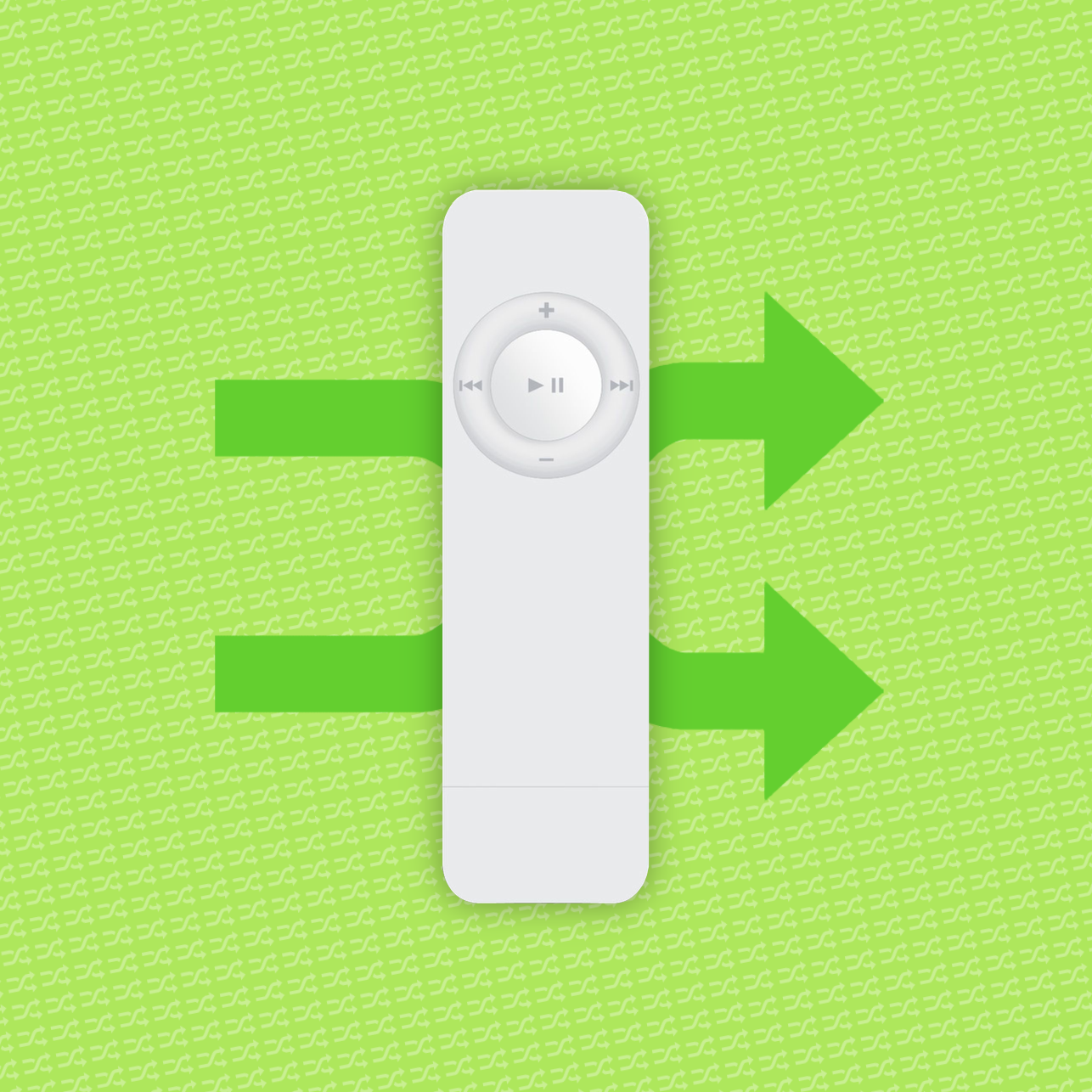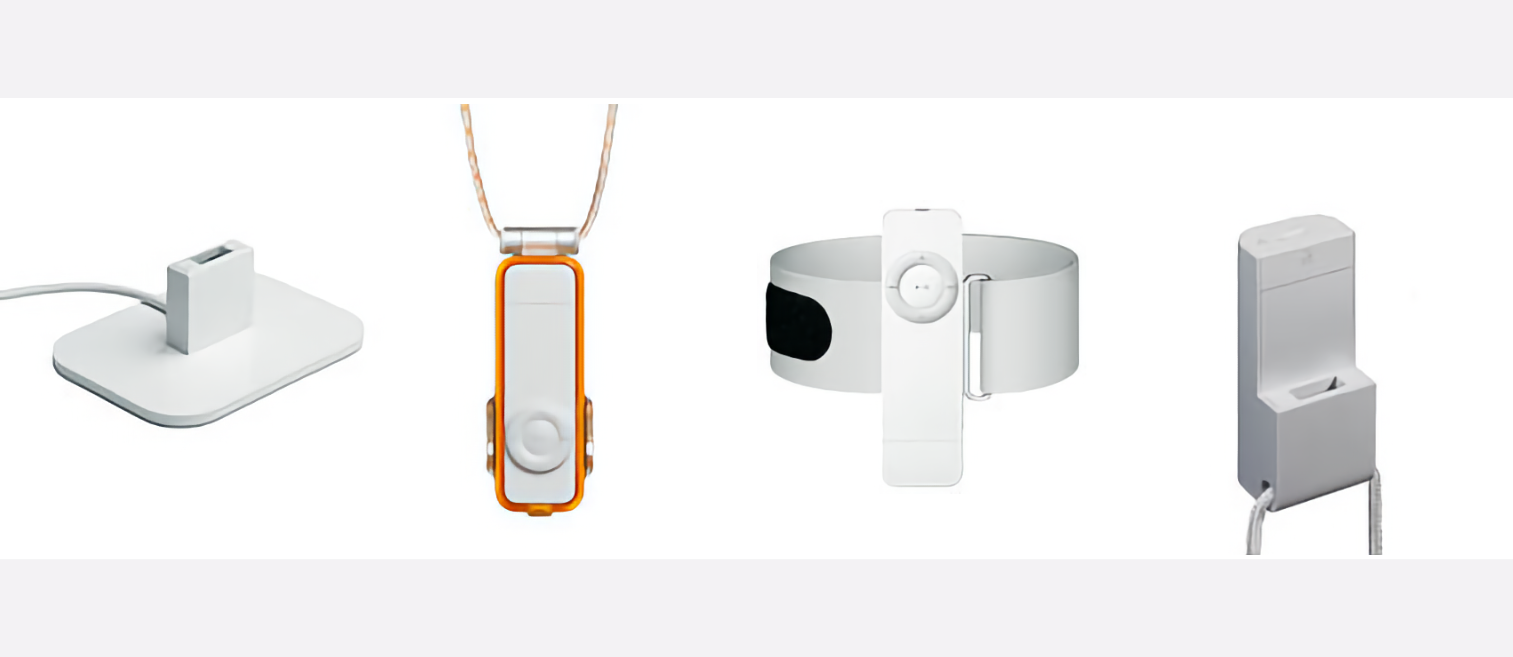iPod shuffle (2005)
Let's first set the stage: The year was 2005, and the iPod line was about to begin its meteoric rise. MP3 players were starting to dominate the landscape, including the emergence of flash-based players, which often had between 64-256MB (yup, megabytes! That's not a typo) of storage, priced in the sub-$150 range.
Apple had already announced the iPod mini a year earlier, intended to go after what Steve referred to as the "high-end flash market." That iPod went on to sell exceptionally well, quickly becoming the best selling iPod in Apple's lineup. But at $249, the mini wasn't able to penetrate the low-end flash market riddled with, as Steve put it, "a zillion" dinky little flash players, which stored anywhere from 16-100 songs.
If Apple wanted to enter this ecosystem, they needed to respond to a few problems that plagued this fragmented market. First, it needed a price that made it a competitive option among existing low-end flash-players (i.e., <$150). Second, they needed a way of quickly navigating between songs and settings. And third, with many MP3 players still relying on replaceable batteries, could Apple incorporate a rechargeable solution into the product so that people weren't replacing batteries every 12 hours?
When Apple announced the iPod shuffle at Macworld 2005, it delivered Apple's first flash-based player starting at $99 (for 512MB; or $149 for 1GB) with a rechargeable battery that lasted 12-hours per charge. So far, so good.
But it was when introducing the user interface that Steve worked us all over with his Reality Distortion Field. You see, this iPod wasn't going to have a screen. Every other low-end MP3 player had a dinky little screen, and Apple had repeatedly lavished praise about how excellent their iPod navigation was. So how do you ship a product that was missing a tentpole feature as glaringly obvious as a screen? You convince people they've never needed one to begin with!
Here was Steve's argument: most of the time we listen to music, we shuffle it. While we might seek out a specific album or song from time to time, most of the time, we're only carrying several dozen of our favourite tunes and tend towards listening to them on shuffle. So while we may say that we want a screen, in reality, most of our interaction with our music doesn't require one. Therefore, because we listen to music on shuffle and consequently don't need to rely on a shrunken or impossible-to-use UI, the iPod shuffle was actually more delightful and easier to use without a screen than if it has included one.
Left to right: The front of the iPod shuffle with playback controls and a headphone jack up top, the iPod shuffle attached to the included lanyard, and the back of the device showing the slider & battery indicator.
Starting at $99, the iPod shuffle was smaller than "most packs of gum" and weighed only 22 grams. Each shuffle came bundled with a set of earbuds, an attachable lanyard (intended for swinging the shuffle wildly around and slapping people in the face while you danced - is at least what I'm inferring based on the commercials), but gasp, no charger. However, it could be plugged into any flush USB-A port to charge.
Interaction with the device was straight forward. Once plugged in, an autofill setting automatically filled the iPod with a random assortment of music selected from your entire library or specific playlists - creating a new on-the-go playlist each time you synced the device. A slider on the back of the device toggled between turning the device off, playing songs in order, or shuffling songs, with a battery indicator below that. A control pad on the front of the shuffle had buttons for play/pause, volume up/down, and previous/next track. And finally, a cap at the bottom of the device could be removed to reveal a USB-A connector for charging the shuffle or connecting it to the Apple's other accessories, including their lanyard, dock, armband, or battery pack.
Along with the shuffle, Apple released several $29 first-party accessories, including a USB dock, iPod shuffle Sport Case, armband, and battery pack powered by two disposable AAA batteries that extended the shuffle's playback time to 20 hours.
The iPod shuffle began a decade-long line of cheaper, screenless iPods that grew in popularity as a light, durable, no-frills music player. Gyms (including their lost and found boxes) were filled with people using this minuscule MP3 player before smartphones exploded onto the market. Over the years, I used the various shuffle's I owned while snowboarding or even as a "backup" iPod when travelling. I possibly also wore it around as a necklace and thinking that I was the most fly kid on the block as a blasted Matchbox Twenty through those tiny, tinny earbuds.
The shuffle's complete story doesn't end here. Still, it does for the pioneering first-generation shuffle, which was discontinued in the fall of 2006 and replaced with the second-generation iPod shuffle after selling over 10-million units.
Misc
If you enjoyed this piece, feel free to like, share, or retweet this article! And if you would like two see more articles like this, reach out to me on twitter - always happy to chat and get feedback!
I actually came across my old-first generation shuffle and even got it to connect to my AirPods Max. Once changed, I was surprised to see that I still had some music preloaded onto the device from the last time I used it.
I had some fun looking through the original iPod shuffle webpage on Apple.com as saved by archive.org.
Apple even included the iPod shuffle as part of SF Symbols.
I'm struck that the original iPod shuffle's launch and the first iPhone announcement are only two years apart. In my mind, it feels like these events are separated by decades, not a couple of years.



